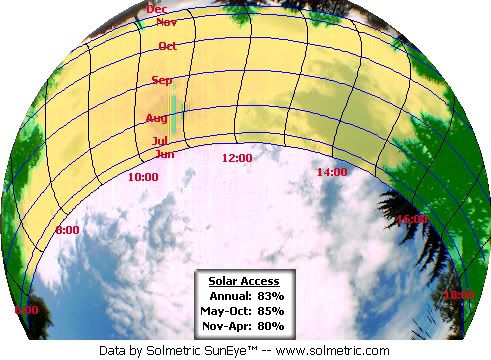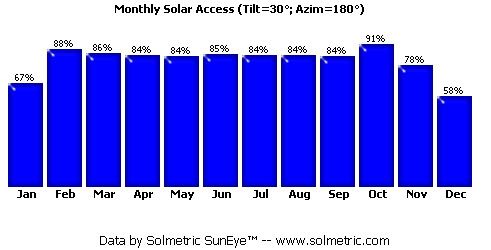Going Solar
Last year, the wife and I attended the Solar Open House here in Seattle. This is an annual event where all the solar/alternative energy households and/or businesses opt to open their doors to show off the cool toys they use to catch the hot sun. Based on a visit to the house with all the features, we had Jeremy Smithson and his buddy Sean of Puget Sound Solar over to the house to evaluate the appropriateness of getting the south roof somehow paneled.
He brought a nifty little gadget that essentially plots our site according to the seasonal transit of the sun.

The gadget takes the above image, notes the amount of any occulting elements and when they would likely become a problem, and gives us the percentage of available sun by seasons.

I was amused and bemused by the amount of extra energy that slight gap in the neighbors' tree coverage gave us for October. Ah, well. That's bound to change, perhaps for the better. The tree coverage to the right of the fish-eye screen just got a whole lot better since the cherry tree fell to the saw and termites. Perhaps the fir will meet a saw-y fate soon. . . .
What can one do with this wealth of sunny energy? Essentially, one can get either solar thermal panels to capture the sun's heat or photovoltaic panels to convert solar radiation directly into electricity. As improved as the photovoltaics have become in both power output per square foot and cost, solar thermal have improved even more.

Here's a Thermomax collector array. The test-tube like protrusions house metal collectors in a vacuum. Once evacuated, air no longer causes convective heat losses on days when the outside air is chilly. In cloudy and often cold Seattle, every little advantage helps. A 20 tube array, the smallest they make, should provide close to or just above 100% of our hot water needs in the summer, letting the heating elements of our electric hot water heater rest for much of the year.
This system will pencil out in the end. It will take a while, but we're assured that after ten years or so the heat it collects will offset the cost of power the water heater would have used. A $2,000 Federal Income Tax Credit and Washington State's suspension of all taxes on purchase and installation both factor significantly into this final cost benefit.
I was a bit bummed we couldn't just upgrade to provide more of our hot water needs for more of the year. Most of the cost involves installation, not hardware, so why not go big? Sadly, one cannot store hot water effectively without major installations like geothermal. Also, if we make more in the summer, we have to dump the heat somewhere to avoid damaging the system (it's not serious damage, but over a certain temp the glycol loses effectiveness and must be replaced). I did ask about a steam turbine connected to a generator, one that would send extra power through the grid. So far, though, no such product exists. I haven't given up. Here's why.
I mentioned tax credits above. Well, the State of Washington now has a tax incentive program geared toward solar, wind and biomass-generated electricity. Install a household system -- one that produces no more than the power the household uses in a year -- and the state will pay extra for every kilowatt/hour generated. Connect to the grid with an inverter built Washington, the credit is $.36/Kilowatt-hour; install both a state-built inverter and solar panel and the rate jumps to $.54! Considering power costs only about six cents per KwHr, that's quite the windfall!
There are only two sad notes to this scheme. Well, three. One may or may not be the fact that the law specifies "photovoltaic" as opposed to "steam turbine." We don't know. I'll have to do more research. The other, more solidly known facts: the incentive program expires in 2014; and there are currently no panel makers in the state. This means I'll have to do something else with all my hot water.
Of course, we could install a hot water dump unit . . . it could resemble and, well, function as a hot tub. . . . That would give us a warmer house in the winter and tub parties all summer! The avoided electrical consumption in the shadier months could pay for the tub over time.
Hmmm. . . . So much to think about. . . .
Oh, and don't forget -- the Solar Open House is coming up, the first Saturday in October!
He brought a nifty little gadget that essentially plots our site according to the seasonal transit of the sun.

The gadget takes the above image, notes the amount of any occulting elements and when they would likely become a problem, and gives us the percentage of available sun by seasons.

I was amused and bemused by the amount of extra energy that slight gap in the neighbors' tree coverage gave us for October. Ah, well. That's bound to change, perhaps for the better. The tree coverage to the right of the fish-eye screen just got a whole lot better since the cherry tree fell to the saw and termites. Perhaps the fir will meet a saw-y fate soon. . . .
What can one do with this wealth of sunny energy? Essentially, one can get either solar thermal panels to capture the sun's heat or photovoltaic panels to convert solar radiation directly into electricity. As improved as the photovoltaics have become in both power output per square foot and cost, solar thermal have improved even more.

Here's a Thermomax collector array. The test-tube like protrusions house metal collectors in a vacuum. Once evacuated, air no longer causes convective heat losses on days when the outside air is chilly. In cloudy and often cold Seattle, every little advantage helps. A 20 tube array, the smallest they make, should provide close to or just above 100% of our hot water needs in the summer, letting the heating elements of our electric hot water heater rest for much of the year.
This system will pencil out in the end. It will take a while, but we're assured that after ten years or so the heat it collects will offset the cost of power the water heater would have used. A $2,000 Federal Income Tax Credit and Washington State's suspension of all taxes on purchase and installation both factor significantly into this final cost benefit.
I was a bit bummed we couldn't just upgrade to provide more of our hot water needs for more of the year. Most of the cost involves installation, not hardware, so why not go big? Sadly, one cannot store hot water effectively without major installations like geothermal. Also, if we make more in the summer, we have to dump the heat somewhere to avoid damaging the system (it's not serious damage, but over a certain temp the glycol loses effectiveness and must be replaced). I did ask about a steam turbine connected to a generator, one that would send extra power through the grid. So far, though, no such product exists. I haven't given up. Here's why.
I mentioned tax credits above. Well, the State of Washington now has a tax incentive program geared toward solar, wind and biomass-generated electricity. Install a household system -- one that produces no more than the power the household uses in a year -- and the state will pay extra for every kilowatt/hour generated. Connect to the grid with an inverter built Washington, the credit is $.36/Kilowatt-hour; install both a state-built inverter and solar panel and the rate jumps to $.54! Considering power costs only about six cents per KwHr, that's quite the windfall!
There are only two sad notes to this scheme. Well, three. One may or may not be the fact that the law specifies "photovoltaic" as opposed to "steam turbine." We don't know. I'll have to do more research. The other, more solidly known facts: the incentive program expires in 2014; and there are currently no panel makers in the state. This means I'll have to do something else with all my hot water.
Of course, we could install a hot water dump unit . . . it could resemble and, well, function as a hot tub. . . . That would give us a warmer house in the winter and tub parties all summer! The avoided electrical consumption in the shadier months could pay for the tub over time.
Hmmm. . . . So much to think about. . . .
Oh, and don't forget -- the Solar Open House is coming up, the first Saturday in October!